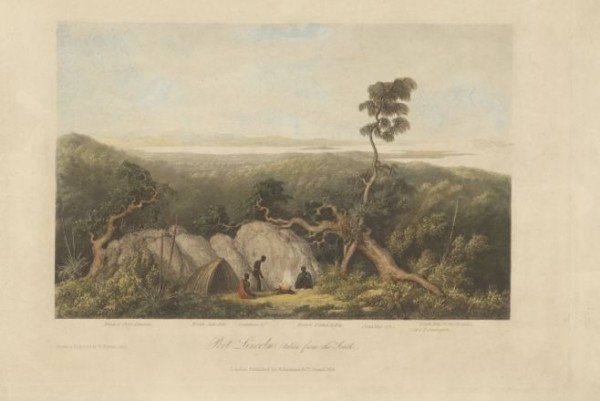In South Australia
On 6 November the Africaine leaves Kangaroo Island for Rapid Bay, though Mary Thomas is reluctant to go without knowing the fate of the six young men who set out to walk to Nepean Bay and who are now considered to be missing. Grave fears are held for their safety. Indeed Mary and Robert Thomas now have first hand experience of the perils of the bush, after losing themselves one afternoon in the scrub adjacent to the beach.
The arrival of the Africaine leaves Colonel Light more anxious than ever. Of course the first question Robert Gouger and the others ask him is where they are to settle and he cannot yet give them an answer. ‘This was not at all satisfactory’, he records in his diary, but he can only advise them to proceed to the safe anchorage at Holdfast Bay. This they agree to do, although not without reluctance. They have all fallen under the spell of the lovely valley near Rapid Bay.
Unfortunately for Light, the first accounts the new arrivals receive of Holdfast Bay are not entirely positive and he must try to soothe their ‘apprehensions’. ‘I had to undergo a little torment, which I kept to myself’, he records, but he holds firm to his view that the wide plain between the sea and the hills is the best place he has yet seen for the settlement. This is a very difficult time for Light and everything seems to conspire against him. He is more than ever convinced that he should have been allowed to sail at least six months in advance of the emigrants and writes to the Commissioners to tell them so. Even after his arrival, bad weather and the delayed arrival of the Cygnet with the other surveyors, has meant that he is far behind in his surveys. And he is still obliged to go to Port Lincoln. We can see his anxiety in the long extracts he transcribes into his journal from his official report to the Company Commissioners. But he remains convinced that he has chosen correctly. ‘This will I am sure be one of the finest plains in the world’, he tells the Commissioners.

Port Lincoln, taken from the south. By William Westel, published 1835. Image courtesy of the National Library of Australia.
Left behind at Rapid Bay, Dr Woodforde is kept busy with his medical duties. Mrs Hoare, wife of one of the labourers, gives birth to a ‘fine boy’, who is promptly named after the Rapid at the doctor’s request. Woodforde also attends to a labourer named Heath, who has injured his hand in fighting. Heath is recovering well, but another man, Bristow, is not so lucky. An inflamed finger, caused by a fishbone injury, is festering and Woodforde thinks that ‘amputation is not improbable’. This will be a fearsome ordeal for Bristow, but may save his life. Woodforde is a lively correspondent, given to pithy observations of his fellow colonists. His diary this week presents a very unflattering image of Kingston, who seems to be generally disliked.
Back on Kangaroo Island meanwhile, from William Deacon we learn that on 12 November four of the six young men finally staggered into Nepean Bay ‘in a dreadful state’. Two are still missing and it is not clear how they came to be separated. From Deacon we also learn of the progress some settlers are making with their gardens, and get a hint of their future aspirations. Deacon seems to have impressed Samuel Stephens who has appointed him to take charge of the Company’s affairs on Kangaroo Island. He seems confident that he will prosper, though he notes that there is little chance of establishing a coffee house ‘at present, especially as spirits are to be had in any quantity’! A hotel, too, is some years off, but is clearly part of the plan in the longer term. In the meantime he must make the best of the labour at his disposal, but he is clearly dissatisfied with the company’s current crop of workers and looks forward to the arrival of ‘the Germans’ to provide some competition.
At sea
The Buffalo is making progress but all on board are cynically amused by the poor seamanship of Captain Hindmarsh. Even Young Bingham Hutchinson’s log for 11 November has a hint of skepticism. As usual George Stevenson is less circumspect and gives us the full story – complete with heavy irony.
Language warning: Please note that these sources contain language which is today considered offensive. It has been retained as it is part of the historical record and evidence of past attitudes.


Comments or Questions: